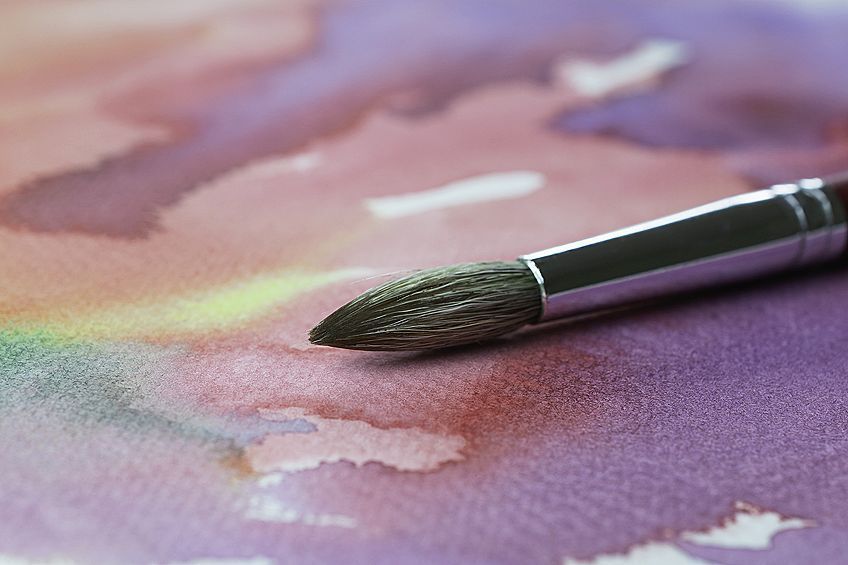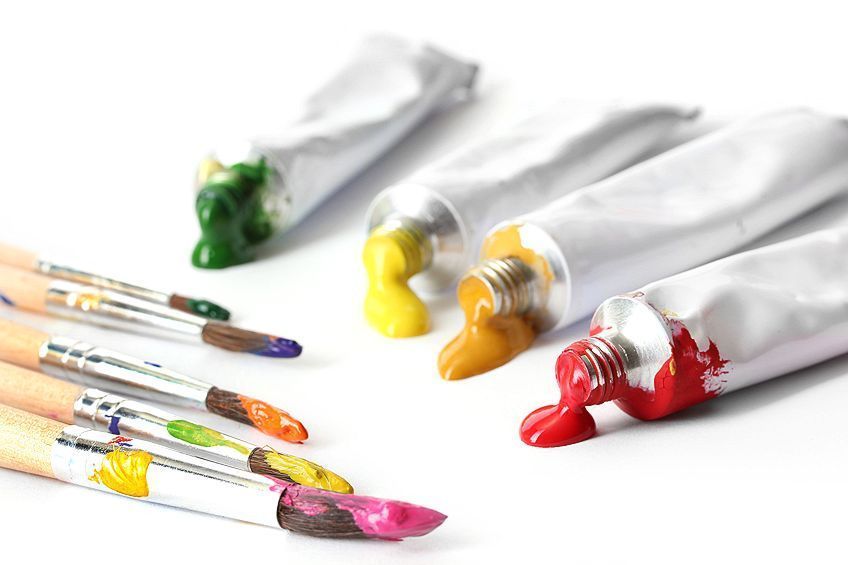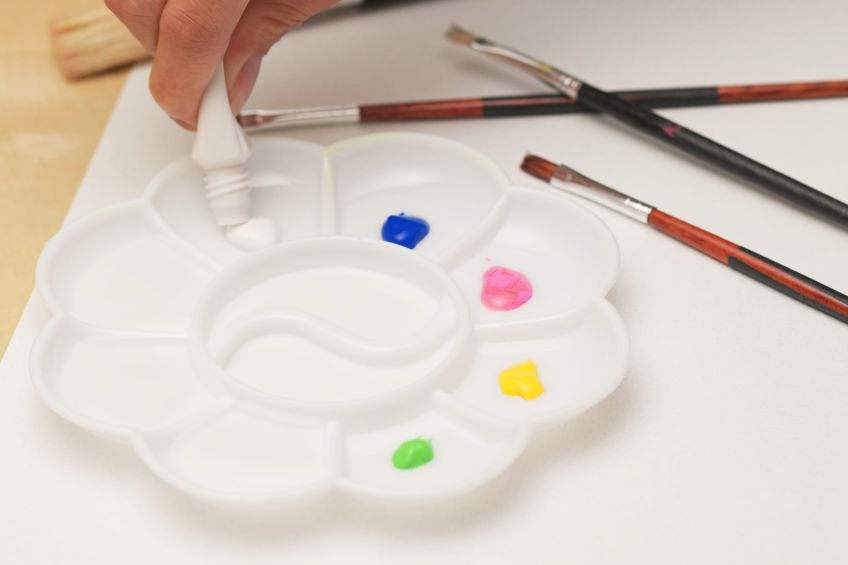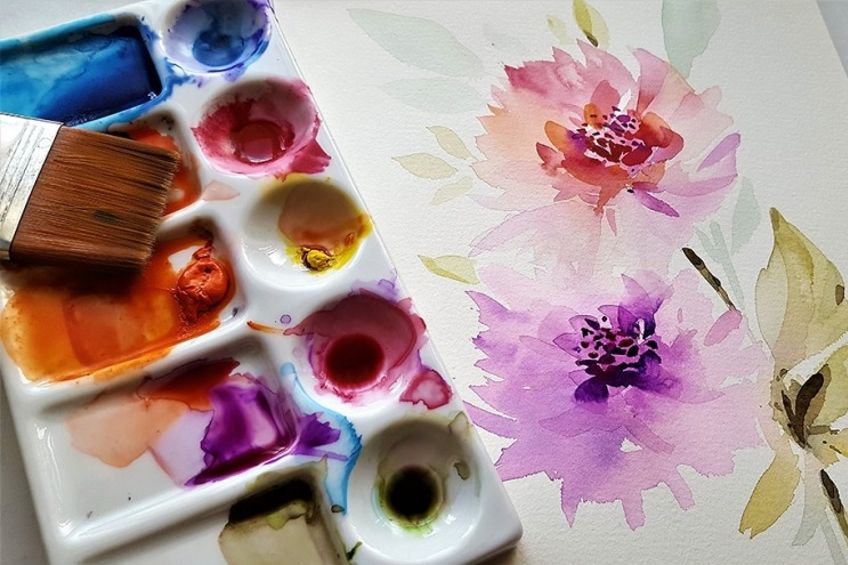How To Use Watercolor Paint In Tubes
This mail service may contain chapter links. We may earn a pocket-sized committee from purchases made through them, at no additional cost to you.
Children, students, and even professional artists love to work with watercolors. There is hardly any mess, no stiff odors from solvents as they are h2o-based, and it is easy to clean up. Watercolors tin can as well be bought anywhere, and they are the most affordable art mediums on the market. The fine art of using tube watercolors is a little difficult for beginners, merely you tin can learn to master it. However, using watercolors in tubes can be challenging and tin can take some practice. And so, we are going to have you through the process step-by-step of how to use watercolor pigment in tubes, helping you to achieve those unique watercolor fine art pieces.
Table of Contents
- 1 A Brief Definition of Watercolor Paints
- two Watercolor Paint in Tubes vs. Watercolor Paint Pans
- 2.one Watercolor Pigment Tubes
- 2.ii Watercolor Paint in Pans
- three How to Utilize Watercolor Paint in Tubes
- three.1 Watercolor Paint Materials
- iii.two Preparing the Mixing Surface
- three.iii Opening Your Paint Tubes
- 3.4 Squeezing the Watercolor onto Your Palette
- 3.5 Preparing Your Mixing Area
- 3.6 Mixing Your Watercolor Paints
- 3.vii Storing and Maintaining Your Watercolor Pigment Tubes
- iv Making Your Own Watercolor Pan
- 5 Frequently Asked Questions
- 5.1 How Many Colors Are Needed to Brainstorm Watercolor Painting?
- 5.2 Can Yous Utilize Pan and Tube Watercolors Together?
- 5.three Is a Paint Tube or Pan Better When Mixing Watercolor Paint?
- 5.4 How Long Do Watercolor Paints Concluding?
A Brief Definition of Watercolor Paints
When a pigment is taken and combined with a h2o-soluble binder, usually glue Arabic, and then a small amount of glycerin is added to give the paint flexibility, adhesion, and a slight gloss end, you lot end up with watercolor pigment. This pigment mixture is and so taken and placed into metal tubes, or the mixture is dried into a solid grade and cut into pans. In the 1400s, artists footing their pigments, mixed them with resin, and fabricated their ain watercolor paints. In the 1700s, manufacturers learned how to dry the paint mixture and cast it into large, premixed slabs. The creative person would then buy a chunk of the slab, take it home with him, and ground information technology into powder. So by adding water, the watercolor paint was ready to employ.

In the 1800s, non only were the artists using tube watercolors but more people, even children, began to pigment with them. Articles presently learned how to reformulate the solid pan paint and came up with metal tubes that contained the paint within. Today, watercolor paints are a lot easier to obtain and come in many vibrant colors both in pan and tube grade. And so, are the pan paints better than the tube paints, or is at that place no departure? Let the states explain this further.
Watercolor Paint in Tubes vs. Watercolor Paint Pans
Watercolor paints are supplied in tubes or pans, and so yous may ask what the difference is? The principal thing to understand is that the quality of the paint in both the watercolors supplied in tubes every bit well as the watercolors sold in pans is the same. The simply difference betwixt the two is that during industry, the watercolors in pans get through an additional procedure of drying, while the watercolors in tubes are poured directly into the tubes and are ready to use.
For the painter, the selection of which type is best is solely a affair of preference. You lot can besides employ both at the same fourth dimension.
Watercolor Paint Tubes
Watercolor paints in tubes are similar to small toothpaste tubes, and the consistency is the aforementioned. They come in three sizes including 5 ml, and fifteen ml, which are the more common sizes used. There is also the twenty ml paint tube. The watercolor paint in the tubes contains more glycerin than that institute in the watercolor pigment pan. This assists with making the paint consistency softer and creamier, which makes information technology easier to mix with the water.
Artists make use of watercolor paint tubes if they are painting large areas, or filling in big sections, which help the painter to keep the intensity of the paint the aforementioned without any variations. The paint from the tube is also highly saturated with pigment that helps the creative person, who is dependent on intensified color, to achieve this goal. The tube paint is also more than flexible and is easier on your brush as you exercise non have to rub it with your brush to selection up the color you want to apply. The watercolor tube paint is more economical and tin can also be used to refill empty pans.

When you use watercolor paint tubes, y'all demand a palette to place the pigment on. You tin then add together your water and mix your paints. This may cause a slight problem if one of the colors gets contaminated by another color on the palette, you lot can then land upwards wasting some pigment. If y'all discover you lot have squeezed out more than paint than you need onto your palette, just exit it, and the next time you lot use information technology, simply add some h2o to the dry paint and you can yet pigment with it.
When using watercolor paint from the tube, you must make sure to make clean the thread of the tube before replacing the cap, otherwise, the paint on the thread tin harden and it volition be hard to open information technology the next time you want to use it. However, if this does happen, then you can hold the cap under some hot water for a couple of seconds, which will aggrandize the cap and as well soften the pigment assuasive y'all to open it easily. You lot should e'er identify the cap back on the tube the moment you lot are finished. Brand sure to supplant information technology correctly, otherwise, the paint will harden and dry in the tube.
If this does happen, and the paint is not too old, y'all can cut the tube in its length and use the open tube every bit a temporary pan.
PROS
- The paint in the tubes has concentrated pigment colors, which will always give you vibrant colors
- Tubes contain a lot of paint, so you need non worry about being left with too little paint
- The hues in the tubes are extremely saturated
- Paint that comes in tubes is great for painting large areas
- Paint tubes can exist used straight from the tube, just add together water
CONS
- You lot may end upwards with dried paint on your palette
- If the cap is non screwed on properly, the paint may dry out in the tube
- It is difficult to work out how much paint you need, which could result in pigment existence wasted
- Contaminated paint on the palette tin can likewise event in wasted pigment
Watercolor Paint in Pans
Watercolor paints in pans are small round or rectangular cakes that are extruded under pressure and then compressed into cakes that are dry to the touch. When water is added to the pans, the paints are activated and ready to use. These cakes are and then fitted into plastic or metallic boxes with hinges that continue the paints in identify, and when the lid is opened, it can serve as a palette to mix your paints.
The pan sets come with certain selected colors, where a complete set will include all the primary colors besides every bit neutral colors. Still, you tin also change the colors or customize them and create your own particular color palette. You can also buy empty pan paint sets and make full them with your ain paint colors. You tin can even buy individual pans and glue them onto your paint pan ready. The watercolor paint in pans is a lot easier to use than the tubes, equally you do not have to get-go put down your brush, open the tube and then squeeze out the paint. The paint is ready to use immediately.

Because the paint pans are compact and easy to transport, it is preferred by many painters who want to pigment while traveling. The paint pans are not equally expensive as the tubes, but they are designed more for modest paintings and small brushes. When you want to start painting, information technology is a practiced idea to first put a drop of water on the colors you want to use and allow information technology stand for a minute or ii. This will soften the paint, making information technology easier to use. To starting time painting, just wet your brush and pick up the paint color you lot want to use. Then place it on the palette, and so you can add together more water if required or mix information technology with any other color you choose.
If you lot want, you can work directly from the pigment pan, but y'all demand to have intendance that you practise not contaminate any of the other colors in the process. To avert this from happening, you can e'er make sure yous wash your brush earlier you pick up new colors from the pan. When you are painting and you lot contaminate other colors, just wait until you lot are finished, then clean them off with a damp cloth. So allow everything to dry for a few hours and so the lid can be closed.
You need to also ensure that you make clean the lid and allow it to dry to ensure that the hat does not stick to the paints, making it difficult to open the box over again.
PROS
- Fewer supplies are needed
- Meaty and easy to transport
- Y'all waste a lot less paint
- Like shooting fish in a barrel to start past only adding h2o
- Lasts a long time, for upwardly to x years or more than
- No problems with the paint drying out as with the tubes
CONS
- Non suitable for larger areas, as it does non continue consistent color
- Brushes tin be damaged due to the continual rubbing to lift the paint off the pan
- If the hat is left uncovered, it tin can attract dust that tin stain your painting
How to Use Watercolor Paint in Tubes
The all-time mode to use paint in tubes is to remove the paint and use information technology directly from the tube. This fashion the paint is nevertheless moist and fix to use; there is no need to first add water to actuate the paint pigments. Another advantage for using directly from the tube is that in that location is a very loftier concentration of pigment, making the colors vibrant and alive. It also guarantees that the pigment y'all are going to utilize is pure, fresh, and clean without any mixing of pigment from other paints.

Watercolor Pigment Materials
You lot tin purchase watercolor paints in a large pick of colors, which include all of the primary colors, which makes them ideal for use in any form of art project. Watercolor paints are bachelor in student, academic as well as artist-grade paints. You should always browse the product labels to confirm you are ownership the paint that suits your project. Watercolor paints are supplied in ii formulations: "staining" and "not-staining". Non-staining watercolor paints remain on the surface of your newspaper, and you can hands remove them by using different "lift-off" techniques.
Staining watercolor paints are drawn into the paper and create a permanent color base.
Preparing the Mixing Surface
Once you accept secured your watercolor paints, the adjacent step is to ensure you lot take a non-absorbent or solid surface for mixing the pigment. Many artists use a butcher's tray or the lid of an empty watercolor pan. Y'all can too use an ordinary dinner plate, only ensure it is white as this will help y'all to see the color mixture. Nosotros strongly suggest that you brand use of a proper mixing palette as it has two separate sections, paint wells and a mixing section.

The paint wells consist of small depressions that are establish on the side of the palette where you can squeeze out your pigment from the tube. The mixing section is used solely for mixing your paints. The use of a mixing palette reduces the possibility of color contamination. Whatever surface you use, make sure that the surface is solid and non-absorbent, otherwise, the pigment will more than likely stick to the surface.
Opening Your Paint Tubes
You may experience that this step is very obvious but be conscientious when y'all remove the cap from the tube. You may not be aware of this, but when yous open the tube, you apply a little pressure, and this may cause the paint to gush out every bit yous remove the hat. Make sure you remove the cap over your mixing surface so that if any pigment does come up gushing out, it volition autumn onto your mixing surface.
If y'all are using an sometime watercolor paint tube, you may experience some dried paint, which tin make it fairly difficult to remove the cap.
To solve this problem, hold the tube upside down in some warm water and the dried pigment will soften enough and so you tin can remove the cap. If you find this problem recurring often, you can dip the cap in some dearest or glycerin before you put it back on the tube, equally glycerin is used in the conception of paint to soften it. When y'all remove the cap, make sure y'all practise not do information technology over your palette or your paper as the dried paint flakes can land on your palette or paper, and it can cause contagion of your colors.
Squeezing the Watercolor onto Your Palette
Now you demand to squeeze some paint onto your mixing surface, making sure it is only a modest dot of paint. Make sure the dots of paint are far abroad from each other to avoid any paint contagion if you lot are using a flat mixing surface like a plate or butcher'south tray. It is a lot easier to employ a proper mixing palette as it has individual paint wells that are separated, and there is no possibility of paint contagion.

Before you beginning to paint, you can add together a drib of water to each paint well which allows you to encounter the colors easier than when the paint has dried. We advise that when yous conform your pigment palette, you lot group the paint into its color family unit. This will help you after when you lot are painting, and then you tin locate the different colors a lot easier. Make sure you prepare your palette with all of the colors you are going to use in your project, as you exercise non want to await around for other colors while you are decorated painting.
Preparing Your Mixing Area
Ensure that the mixing area is completely separated from the small dots of paint and then that your watercolor paints remain pure. Now load your paintbrush with some water and drop information technology off in a separate infinite on your mixing surface.
This will be your mixing area where you lot will be mixing your watercolor paints.
Mixing Your Watercolor Paints
Prepare two containers with clean water, which yous volition be using during your painting to wash your brushes in. Moisten your brush with some water and tap off the excess water, then you tin can gently lift the dot of paint from your pigment well. You only want a pocket-sized amount of paint on your brush as it is easier for you to add together more at a later phase.
Afterwards you have picked up your paint on the castor, mix information technology in the small puddle of water you dropped onto your mixing surface. Try not to splash any of the pigment into the other paint wells. If you desire to add together another color, wash your brush first, or use a new castor to keep your pigment colour pure and vibrant. When working with watercolors, it is always better to add your paint to the water and not the other way around.

You may find washing your brush after each pigment color a bit tedious, but if you lot practice non, you lot run the risk of contaminating your paint colors. Then, you need to make sure your castor is clean after each color modify. Now that you lot are satisfied with the shade of color you want, you lot can offset applying it to your paper. When yous want to paint a broad surface area, you can just printing down on your brush more or use another brush that is a unlike size.
Y'all tin can likewise use ii or more than paint colors and mix them, creating new color blends. Take a small-scale corporeality of another colour and mix information technology in a pool of h2o until y'all are satisfied with the colour. Always use a carve up puddle for mixing other colors to avert color contamination.
Storing and Maintaining Your Watercolor Paint Tubes
Ensure that you wipe all the excess paint off the tube after you squeezed the paint out to ensure that no paint is left on the tube. Any leftover pigment will cause difficulty when trying the remove the cap when y'all use the paint tube over again. Y'all tin use a paper towel or clean cloth to do the chore, and for actress cleaning, you tin wipe the tube with some mineral spirits.
Try to keep all of your paint tubes together in one identify, which makes information technology a lot easier to locate them when you want to paint over again.
Brand sure you lot store your watercolor in tubes in a dry out cool identify, as too much estrus can scissure the tubes and cause them to flare-up open. The ideal state of affairs is to store them in an airtight container or lock them in a draw or a cupboard if you do not take an airtight container.
Making Your Ain Watercolor Pan
To make your own watercolor pan, yous can employ watercolor tubes, or you tin purchase separate watercolor paint that is already in a pan. Then you need an empty palette box that comes in one-half pans or full pans and some extra empty pans. At present you need to make up one's mind what color palette you want so y'all can personalize the palette box. And then y'all must decide how the colors are to be laid out. This makes it simpler when you are busy painting as y'all know exactly where each color is situated. Making your ain watercolor pan is also more than cost-constructive as you can only meridian upwardly the colors when they are depleted.

It is a skilful idea to label the color with a color name, a pigment number, and a brand. This should be helpful the next time you desire to refill your palette. Squeeze some of the paint from the tube into the corner of your pan and and so fill the pan halfway. And then stir the paint with a toothpick or paper clip to remove any air bubbles that can cause the paint to dry out out. Leave the pans you filled to dry and do not cover them but dry out them in a place that is well ventilated. Equally presently as the paint is dry, fill up the pan, but not correct to the top so you accept space to add some water. As well, you demand infinite so that the pigment does non stick to the chapeau. This procedure of filling the pans in two stages is to avoid the pigment from cracking and evaporating.
Whether y'all are a professional artist or you just love painting, watercolor in tubes makes the task a lot easier. All you need to do is put a pocket-sized dot of paint on your plate or palette, accept a wet castor and pull your colors onto the paper, and begin painting. It is that unproblematic.
Often Asked Questions
How Many Colors Are Needed to Begin Watercolor Painting?
You cannot become wrong with the three master colors. When mixing them, you can create whatever colour you want. Still, if you lot are only starting, so 1 colour is all you need, just take one tube of pigment and by adding water, you tin can make the color lighter, or past layering the colors, you tin also darken the colour.
Can You Utilize Pan and Tube Watercolors Together?
Yes, you can use watercolor paints from a pan and a tube, and these can exist used together in the aforementioned painting. You can besides mix the watercolor pigment from the tube with those from the pan on your plate or your palette.
Is a Paint Tube or Pan Better When Mixing Watercolor Pigment?
When mixing watercolor pigment, information technology is best to utilize watercolor paint directly from the tube rather than from a pan, as the pigment is always fresh and moist. Using a paint melody is also easier when mixing large amounts of paint for a large surface area.
How Long Practise Watercolor Paints Concluding?
There is no shelf life for watercolor paints. Some artists accept taken their watercolor paints that are fifteen years onetime, and past merely adding some water, the paints were as practiced as new. As long equally you lot proceed the paints in a dry dark place where there is no straight sunlight, it should preserve the pigment colors.
How To Use Watercolor Paint In Tubes,
Source: https://acrylgiessen.com/en/how-to-use-watercolor-paint-in-tubes/
Posted by: millersentwo1953.blogspot.com


0 Response to "How To Use Watercolor Paint In Tubes"
Post a Comment